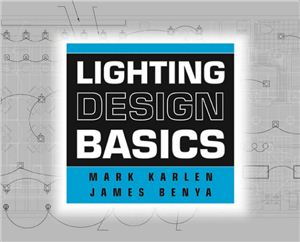Mark Karlen, James Benya. Lighting Design Basics. John Wiley &
Sons, Inc. , 2004. - 192 p.
Lighting is a basic, yet difficult-to-master, element of interior design, and Lighting Design Basics provides the information you need in a concise, highly visual format. Two leading designers, both with decades of experience, offer straightforward coverage of concepts and techniques, and present realistic goals you can use as guides to creating simple, typical lighting designs and when collaborating with professional designers on more complex projects.
Design scenarios for more than twenty different spaces illustrate real-world case studies for illuminating residential and commercial spaces, from kitchens to doctors' offices. Each scenario includes an in-depth rationale for the proposed solution, insightful lighting distribution diagrams, floor plans, and details for lighting installation and construction. In addition, exercises allow you to develop lighting design skills in preparation for working on actual projects, as well as the NCIDQ and NCARB exams.
Packed with informative illustrations, Lighting Design Basics is an invaluable resource for students, as well as interior designers and architects studying for professional licensing exams.
Preface.
Chapter
1. Introduction: How to Use This Book.
Chapter
2. Light Sources.
Chapter
3. Luminaires.
Chapter
4. Switching and Dimming.
Chapter
5. Daylighting.
Chapter
6. Lighting Calculations.
Chapter
7. Documenting Lighting Design.
Chapter
8. Lighting Concepts: The Layers Approach.
Chapter
9. A Basic Approach to Lighting Design.
Chapter
10. Residential Lighting Design.
Chapter
11. Office and Corporate Lighting Design.
Chapter
12. Hospitality Lighting Design.
Chapter
13. Health Care/Institutional Lighting Design.
Chapter
14. Lighting for Stores.
Chapter
15. Lighting Common Spaces.
Chapter
16. The Professional Process of Lighting.
Chapter
17. Collaborating with Lighting Designers.
Chapter
18. Computers and Lighting Design.
Chapter
19. Developing Skills Beyond the Basics.
Appendix A. Educational Programs in Lighting.
Appendix B. Energy Codes.
Resources.
Index.
Lighting is a basic, yet difficult-to-master, element of interior design, and Lighting Design Basics provides the information you need in a concise, highly visual format. Two leading designers, both with decades of experience, offer straightforward coverage of concepts and techniques, and present realistic goals you can use as guides to creating simple, typical lighting designs and when collaborating with professional designers on more complex projects.
Design scenarios for more than twenty different spaces illustrate real-world case studies for illuminating residential and commercial spaces, from kitchens to doctors' offices. Each scenario includes an in-depth rationale for the proposed solution, insightful lighting distribution diagrams, floor plans, and details for lighting installation and construction. In addition, exercises allow you to develop lighting design skills in preparation for working on actual projects, as well as the NCIDQ and NCARB exams.
Packed with informative illustrations, Lighting Design Basics is an invaluable resource for students, as well as interior designers and architects studying for professional licensing exams.
Preface.
Chapter
1. Introduction: How to Use This Book.
Chapter
2. Light Sources.
Chapter
3. Luminaires.
Chapter
4. Switching and Dimming.
Chapter
5. Daylighting.
Chapter
6. Lighting Calculations.
Chapter
7. Documenting Lighting Design.
Chapter
8. Lighting Concepts: The Layers Approach.
Chapter
9. A Basic Approach to Lighting Design.
Chapter
10. Residential Lighting Design.
Chapter
11. Office and Corporate Lighting Design.
Chapter
12. Hospitality Lighting Design.
Chapter
13. Health Care/Institutional Lighting Design.
Chapter
14. Lighting for Stores.
Chapter
15. Lighting Common Spaces.
Chapter
16. The Professional Process of Lighting.
Chapter
17. Collaborating with Lighting Designers.
Chapter
18. Computers and Lighting Design.
Chapter
19. Developing Skills Beyond the Basics.
Appendix A. Educational Programs in Lighting.
Appendix B. Energy Codes.
Resources.
Index.

